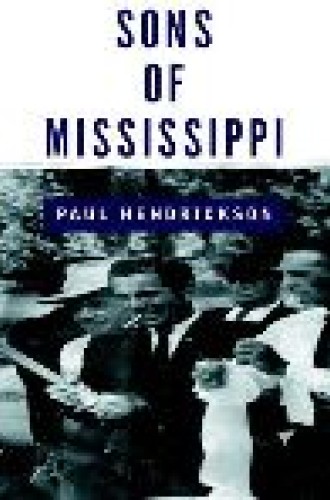Sons of Mississippi
One picture has become a symbol of white resistance to James Meredith’s 1962 entrance to the University of Mississippi as its first African-American student: the Life magazine photograph, taken by Charlie Moore, showing seven white sheriffs gathered in a campus grove, one of them swinging a billy club. Paul Hendrickson, an award-winning Washington Post writer who now teaches at the University of Pennsylvania, uses this picture to illuminate an important chapter in U.S. history.
Hendrickson investigates what happened to the people whose “100-year-old way of life was cracking beneath them.” He set out to talk to the lawmen in the famous photograph and to their descendants to learn whether the rage represented in that picture had been passed on to succeeding generations. “Where did the hatred and the sorrow go that flowed out of the moment?” he asks. He wants to discover who these men were, what happened to them, and how their racist attitudes remained or changed over the years. Are the “sins of the fathers” indeed passed down to generations to come? How does “a gene of intolerance and racial fear” mutate as it passes through generations?
Hendrickson also offers a powerful portrait of James Meredith himself. Now aging, sick and easy to ridicule because of his bizarre words and actions, Meredith nevertheless will always represent the courage needed in that era—a courage those who never knew the Mississippi of the 1960s may find hard to understand.
Though all the men in the photograph are now dead, Hendrickson was able to talk with two of them, Billy Ferrell and John Ed Cothran, before their deaths. Ferrell followed in his father’s footsteps both as sheriff and as president of the National Sheriffs’ Association. His grandson is with the U.S. Border Patrol. They are like many middle-class white Mississippians—conflicted over race, but relatively at peace with the past. In the Cothran family one sees the struggle of what Tex Sample calls “hard-living people,” people who reflect the difficulty of change in their daily struggles. Hendrickson is at his best in writing about the college- educated Ferrell grandson and the blue-collar Cothran grandson. But the kind of generational redemption that he seems to have been hoping for never quite happens. As one reviewer has said, Hendrickson found only “spoonfuls of redemption.”
Yet nothing is ever simple and neat in Mississippi. Hendrickson captures the irony of a state with a shameful past but also remarkable achievements. A part of that irony is that Meredith’s son Joe, a Harvard graduate, received his Ph.D. at “Ole Miss” in 2002, 40 years after his father’s tumultous entry into that university. Top university officials were unaware of his presence until shortly before his graduation.
Hendrickson reminds us that while there has been no total redemption, there are glimmers of hope for the sons and daughters of Mississippi. One such moment came last summer on the 40th anniversary of the murder of three civil rights workers in Philadelphia, Mississippi. In a service held in Philadelphia, white, African American and Choctaw citizens joined the families of the slain civil rights workers to offer apologies and to call for justice for all involved in the crimes. A white Philadelphia native and former Mississippi secretary of state, Dick Molpus, told the gathering: “We know today that our enemies are not each other. Our enemies are ignorance, illiteracy, poverty, racism . . . We can defeat all those enemies . . . as a united force banded together by our common humanity—by our own desire to lift each other up. Forty years from now I want our children and grandchildren to look back on us and what we did and say that we had the courage, the wisdom and the strength to rise up, to take the responsibility to right historical wrongs.”






